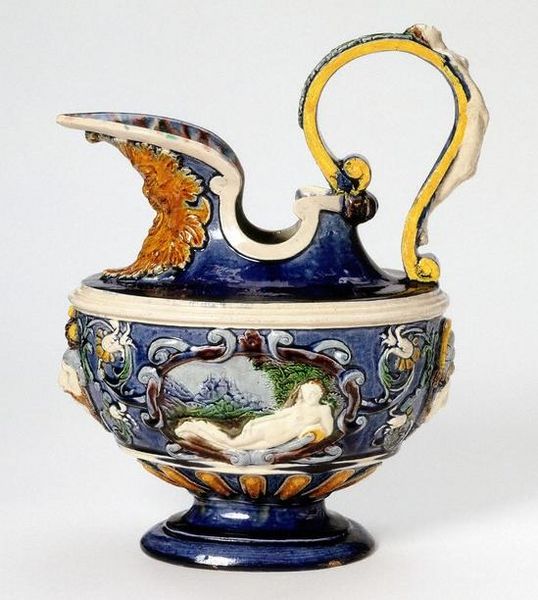Image: Palissy

Description: Ewer [helemt spout, scroll handle], 1580-1600, Bernard Palissy V&A Museum no. 7178-1860 Techniques - Lead-glazed earthenware, moulded, with applied decoration Place - France Dimensions - Height 27.5 cm Width 22.5 cm Depth 15 cm Object Type - This jug, or ewer, was acquired in 1860 by the Museum at a time when the cult status of the French Renaissance potter Bernard Palissy (1509/1510-about 1590) was rapidly escalating in Britain and France. Acquired as part of the Jules Soulages Collection, the Palissy wares were described as 'a series of the highest aesthetic value ... (A)ccess to such examples must improve the taste of the people'. Although now known to be by a follower rather than by the great ceramicist himself, this ewer bears all the hallmarks of Palissy's own wares of around 1575-1590. In the 19th century the ownership of a work by Palissy would have been the crowning glory of an antiquarian's collection. People - Bernard Palissy was the most celebrated of French potters. At his death he was followed by a school of imitators and was elevated to romantic, heroic status in the 19th century. The cult of Palissy gradually developed between the 17th century and the 19th: his immediate followers, working in his technique and style, confused the identification of any possibly genuine production. His writings were published in highly censored form in the 17th century and then unedited in the 18th century. In the 19th century it became impossible to separate the man from the myth that had grown up around him. This myth was as enthusiastically cherished in Britain as in France, not least owing to Minton's own Palissy-ware. In the Museum he was awarded a window of his own in the Ceramic Gallery (now the Silver Gallery), in company with Luca della Robbia (1399/1400-1482) and Josiah Wedgwood (1730-1795). Design & Designing - Although he was a great self-publicist, whose name is associated with several different types of ceramic, and although some moulds still exist, there are very few ceramic works surviving that are known to be by Palissy himself and his atelier. Perhaps best-known of the ceramics associated with him are those original and innovative wares called 'rustic', which incorporate cast elements such as leaves, reptiles and water creatures. These were developed in response to the fashion for Italian-style grottoes introduced into France in the mid-16th century. But Palissy was also a skilful interpreter in ceramic of classical Renaissance ornament of strapwork, masks, grotesques and panels enclosing scenes of classical figures as allegories. Source: http://images.vam.ac.uk/indexplus/page/Home.html
Title: Palissy
Credit: Transferred from en.wikipedia to Commons.
Author: The original uploader was VAwebteam at English Wikipedia.
Usage Terms: Creative Commons Attribution-Share Alike 3.0
License: CC BY-SA 3.0
License Link: http://creativecommons.org/licenses/by-sa/3.0/
Attribution Required?: Yes
Image usage
The following page links to this image:

